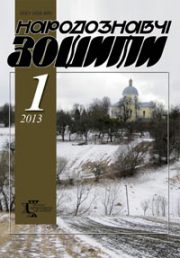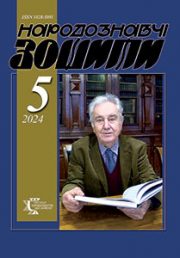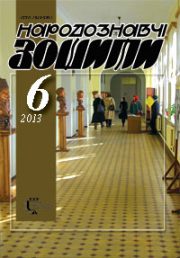The Ethnology Notebooks. 2023. № 6 (174), 1354—1364
UDK [746.4:27-525.7](477)”17/19″
DOI https://doi.org/10.15407/nz2023.06.1354
OLIYNYK Olha
- ORCID ID: https://orcid.org/0000-0002-7292-3264
- Сandidate of Аrts (Ph. D), Researcher at the Folk
- Art Department of Ethnology Institute
- of the National Academy of Sciences of Ukraine,
- 15, Svobody Avenue, 79000, Lviv, Ukraine,
- Contacts: e-mail: oliao1610mac@gmail.com
Abstract. Introduction. The phenomenon of goldwork embroidery in 19th century shrouds, which received rather skeptical evaluations among specialists regarding its artistic and technical qualities, is unique in its appearance and development, an example of the synthesis of decorative and pictorial concepts that have received more than a century of development in Ukraine. Ambiguously perceived by art researchers of the time, today these works acquire a chamber sound, bring elegiac to the temple space, and the decorative textural effects of voluminous golden stitches and shimmering decorations cause admiration and aesthetic pleasure.
The purpose of the article is to analyze the means of decorative expressiveness of quilting in Ukrainian shrouds of the specified period, the influence of technological methods on stylistics, the expression of the artistic form of pictorial embroidery and ornamental stitching.
The direct object of the studies are the works of church tailoring — Ukrainian Epitaphios of the end of the 18th — beginning of the 20th centuries, preserved in museum collections and recorded directly in the churches of Ukraine. As a subject, the analysis of the arsenal of decorative means and the role of technological methods of happing in the formation of artistic features of Ukrainian shrouds, the stylistics of individual cells are outlined.
For the first time, scientific interest is focused on the study of the means of decorative expressiveness of Ukrainian works of the XIX — early 20th century, most of which the author introduces into scientific circulation after being fixed in the field and carrying out their attribution.
The research was carried out by applying general scientific research methods (analysis, synthesis, comparison, generalization) and special art methods (formal-iconographic and comparative-stylistic analysis).
The source base became: professional publications of Ukrainian and Russian scientists in the field of liturgical sewing, in particular technological features of «golden» quilting «on the card», «in splits», decoration with cords, beads, metal and glass trinkets; material monuments from the collections of Ukrainian museums and materials of the author’s many years of field research in Galicia, Volhynia, Polissia and Bukovina.
Conclusion. Based on visual observations, the article analyzes the techniques of quilting and decorating shrouds of the 18th—19th centuries, which reveal the originality of Ukrainian works: the richness of texture and tone, the folklorization of ornament, the variability of decorative means. The uniqueness of shrouds with three-dimensional plastic «golden» stitching is noted as a phenomenon in Ukrainian decorative art, in which the pictorial idea and decorative addition are combined.
Keywords: shroud, stitching, goldwork embroidery, decorative means, gold wire thread, stitch, texture.
Received 13.11.2023
REFERENCES
- Deryabina, Tatiana Yuryevna. (2014). Archaic and traditional technologies in the modern design of church textiles: thesis. … candidate of technical sciences: 17.00.06. Saint Petersburg State University of Technology and Design. St. Petersburg [in Russian].
- Verbytskyi, L. (1885). Church vestments, felons and embroideries. Polish-Russian Archaeological Exhibition organized in Lviv in 1885 (Pp. 3—8). Lviv [in Ukrainian].
- Kara-Vasyleva, T.V. (2000). Masterpieces of church sewing of Ukraine (XII— XX centuries). Kyiv: UOC center [in Ukrainian].
- Serkova, T.V. (2003). Methodical manual on face sewing: theory and practice (for Easter school courses and for independent study church sewing). The second hour of training. Moscow: Publishing Department Charitable Fund «Pokrov» [in Russian].
- Katasonova, E.Yu. (Ed.). (2007). Sewing «attachment» according to the form. Tablecloth. Church sewing. History and modernity (Vol. 8). St. Petersburg: Zolotoshveinaya masterskaya Ubrus [in Russian].
- Katasonova, E.Yu. (Ed.). (2007). Sewing «attachment» on account. Tablecloth. Church sewing. History and modernity (Vol. 9—10). St. Petersburg: Zolotoshveinaya masterskaya Ubrus [in Russian].
- (1908). Catalog of the exhibition of the XIV Archaeological Congress in Chernihiv (Pp. 25—46). Chernihiv [in Russian].
- (1908). Description of physical and written monuments of the Chernihiv eparchial wood storage. Collection of the Chernihiv eparchial tree repository (Vol. 1, pp. 1—50). Chernihiv [in Russian].
- Trypolskyi, V. (1909). Poltava Eparchyal Wood Archive: index with a description of outstanding written and material monuments of church antiquity of the Poltava Eparchy. Poltava [in Russian].







